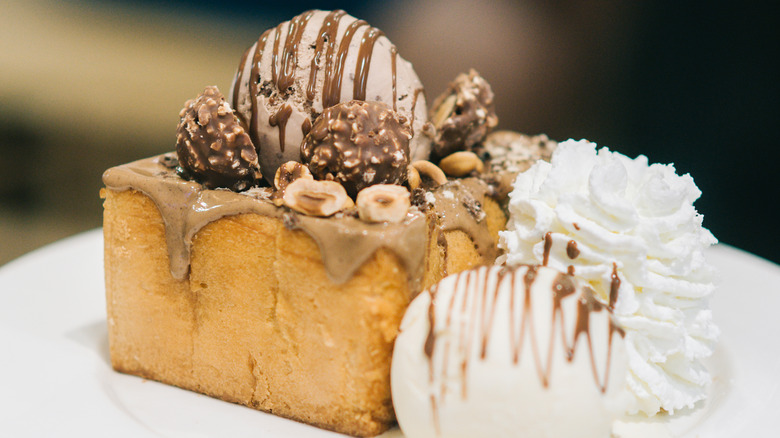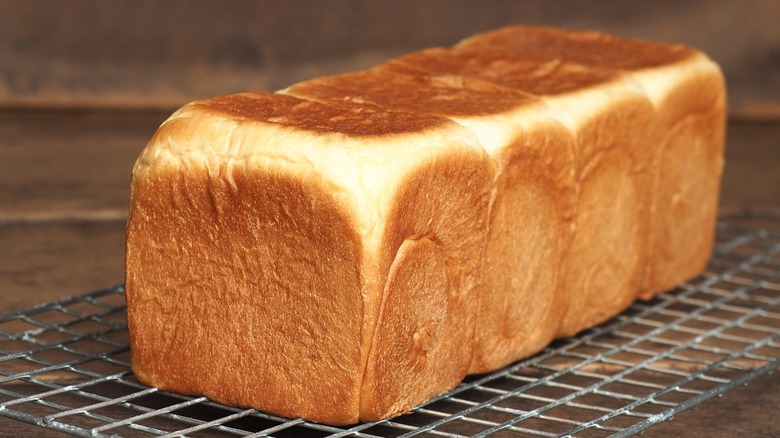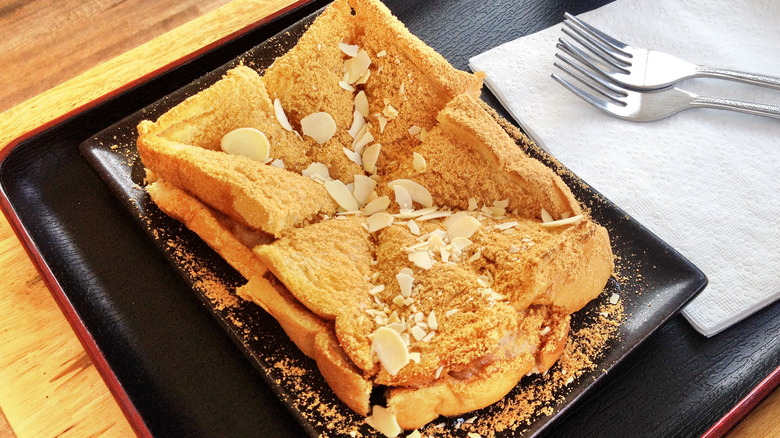What, Exactly, Is Honey Toast?
Out of all the ways you can eat bread, honey toast is arguably one of the best. Both bread and sugar fans alike will be able to appreciate the simplicity of this dessert-like snack — or snack-like dessert, depending on how extravagantly you make it. Honey toast goes by many different names, some of which you may have encountered in Asian cafes and bakeries; these include brick toast and Shibuya toast. The latter is a direct reference to honey toast's likely place of origin: Shibuya, Japan.
The honey toast that you'll find in many Japanese cafes is made from roughly 5-inch-thick slices of bread, typically Japanese milk bread. In fact, they're so thick that they probably shouldn't be called slices. This bread brick is either deeply scored, or its insides are hollowed out and cubed. The whole thing then gets toasted, and the bread cubes are placed back inside of the bread's crust. Then, the other half of its namesake is added: a healthy drizzle of honey. You can also add sweet accompaniments like ice cream, whipped cream, and fruit. Both the assembly of the honey toast and its toppings vary significantly depending on where you get it, but you can be sure that the bread will be toasted and that honey will be present.
The bread is key
Honey toast is a bread-based dessert, so the quality of the bread matters. A solid milk bread recipe is arguably the key to a more authentic, better-tasting honey toast. Even though this cloud-like white bread is typically used for sandwiches, its subtle sweetness makes it the perfect base for sweet accompaniments, easily turning it into a dessert. There are no exact rules on how thick, thin, or blocky the milk bread should be before it becomes honey toast. However you want to slice it, any toasted bread with honey is fair game.
Traditionally, a 5-inch slice (or thicker) is the way to go. If you don't have the luxury of such a thick block, stacking multiple slices on top of each other is another common way to achieve height for the toast. Since individual slices can't be used to create the giant bread crust bowl, the thin slices often get cut through to allow honey and toppings to seep in. A single slice of bread, too, makes a better honey toast when it's scored or sliced before toasting.
You can find honey toast internationally
The ease with which honey toast can be made (not to mention its customizable nature) has helped it spread internationally. Although it originates in Japan, geographic neighbors like Korea and Taiwan have also taken a liking to this dessert, and it has even made its way into mainstream coffee shops. Tom N Toms is one of the biggest coffee chains in Korea, with over 400 domestic stores and nearly 100 international locations. On its menu, it represents honey toast in two styles: honey butter (with cinnamon and whipped cream) and honey nut butter (with almonds and caramel sauce). In Taiwan, too, honey toast is a popular snack menu item at boba shops and often carries toppings like peanut butter, Nutella, and custard.
Those who want to try honey toast in the U.S. should seek out big cities like Los Angeles. In LA's Koreatown, chances are you can find honey toast at patbingsu (Korean shaved ice) shops. The popular shop Sul & Beans, which has eight locations across the West Coast and Texas, serves a whopping seven styles of "brick toast" with Korean toppings like injeolmi, a chewy rice cake. If you can't find honey toast at a cafe near you, making this two-ingredient (or more) toast at home is relatively quick and easy.


